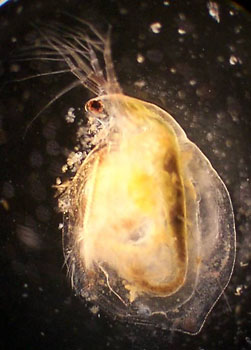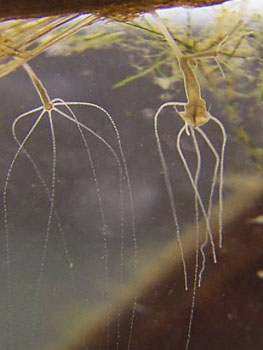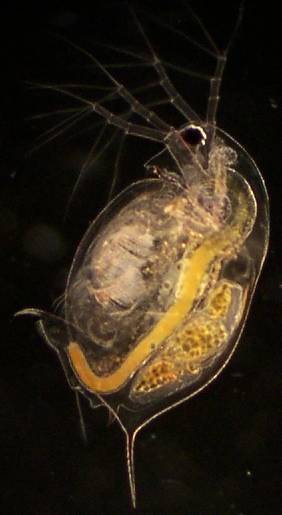Introduction:
When I started this series of articles, I only intended to write three; but such is the nature of writing. One of the advantages of writing articles (and this is a blatant plug to encourage others to write) is the discipline it imposes to one's thinking. It is one thing to play around with a microscope and daphnia, but writing (at least for me) forces one to question closely what they are writing about - is the identification correct, is the picture as well focused as it could be, can I identify all the steps of the procedure. And out of that process, new things are found; through e-mail responses and further research.Since I finished the first three articles, I have come upon another simple technique that delivers good results, and have explored a new site with new species (at least to my collecting).
Issue:
Though collecting daphnia with a baster bulb (see the prior article) works well for collecting, it has two limitations; one is that I can only reach an arm's length from shore, and the other is the risk of slipping in the mud and falling into the pond. However, I have liked collecting with a baster because it gives me a more 'targeted' sample than just dipping a cup or jar into the water.Two pieces of equipment have converged to provide another technique.
Filter:

I have tried filtering samples before, but with poor results. Coffee filters and paper towels tend to trap the daphnia in the paper fibers, and also quickly clog with particles of dirt. From a recent suggestion, I tried using silk-screening fabric, and liked the results. The fabric has a small enough weave to catch the smallest daphnia (and rotifers), yet does not readily clog. They also rinse off of the fabric with just a few drops of water.
I took a ring of 4 inch PVC drain pipe, and covered it with a piece of fabric; holding it in place with a hose clamp. I did not stretch it tight, but left it with an indentation in the fabric. In this way, when I pour water through it, the water can form a small pool, rather than spilling over the edge. I filter with the fabric on top of the ring (rather than with the fabric at the bottom of the ring) so the daphnia do not get caught between the fabric and the edge of the plastic.
 I
use this filter in two ways. One is to pour cups of water through it as
I am collecting them, the other is to pour cups of water into a bucket,
then pour the bucket through the filter all at once. Both ways seem to
work equally well.
I
use this filter in two ways. One is to pour cups of water through it as
I am collecting them, the other is to pour cups of water into a bucket,
then pour the bucket through the filter all at once. Both ways seem to
work equally well.
Collecting Tool:
For a number of years I have carried around a walking stick made out of a length of 3/4 inch electrical conduit PVC. It has a rubber cane tip on one end, and a plastic cap on the other. I had put a brass bolt through the cap, (drill the hole slightly smaller than the bolt, and screw it in from the bottom), so that the walking stick would double as a camera mono-pod. It was easy enough to drill a whole in the side of a plastic cup and attach it to this bolt.With this tool I have easily extended my reach, whether farther out, or deeper into the water.
Observations:
Tower Grove Park, St Louis, MO (UTM 15 738835E 4276557N)

Tower Grove is a delightful old park, with an interesting history. Henry Shaw, who was originally from England, came to St. Louis in 1819 with a boat load of merchandise. When he sold these goods, he opened up a store; and quickly made a fortune. He retired in 1858; and after some traveling, spent the rest of his life collecting botanical specimens from around the world. These were brought back, and grown on the grounds of his summer estate. When he died, part of his property became what is now the Missouri Botanical Gardens, another parcel was given to the 'people of the city of St. Louis', as Tower Grove Park. A number of years ago, when the city thought they could use this undeveloped land for a new highway, they quickly discovered the careful choosing of his words - it was given to the people, not to the city of St. Louis.
Near the middle of this park is a series of Victorian lily ponds, which were added in 1902. The ponds are artificial (no natural water flow). With the introduction of non-native water plants, it is possible that many of the daphnia were 'imported' from unknown locations. However, everything I have found to date is fairly common to the local. The dominant species was Ceriodaphnia quadrangula and Chydoridae. I had about finished scanning the slides when I noticed one of the specimens (and only one) had a tail spine (definitely not a Ceriodaphnia!), unfortunately the rest of it was crushed beyond clear identification. A search of the rest of the bottle found two Daphnia pulex (which I have not found before in St. Louis). I usually grab a few pieces of plant, and was rewarded with a nice large hydra.


